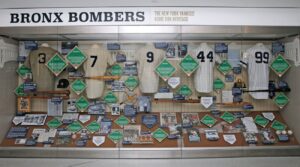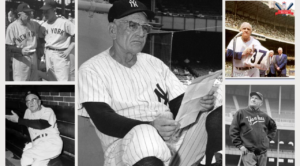Casey Stengel: The Yankees’ Ol’ Perfessor, 7-time champion manager
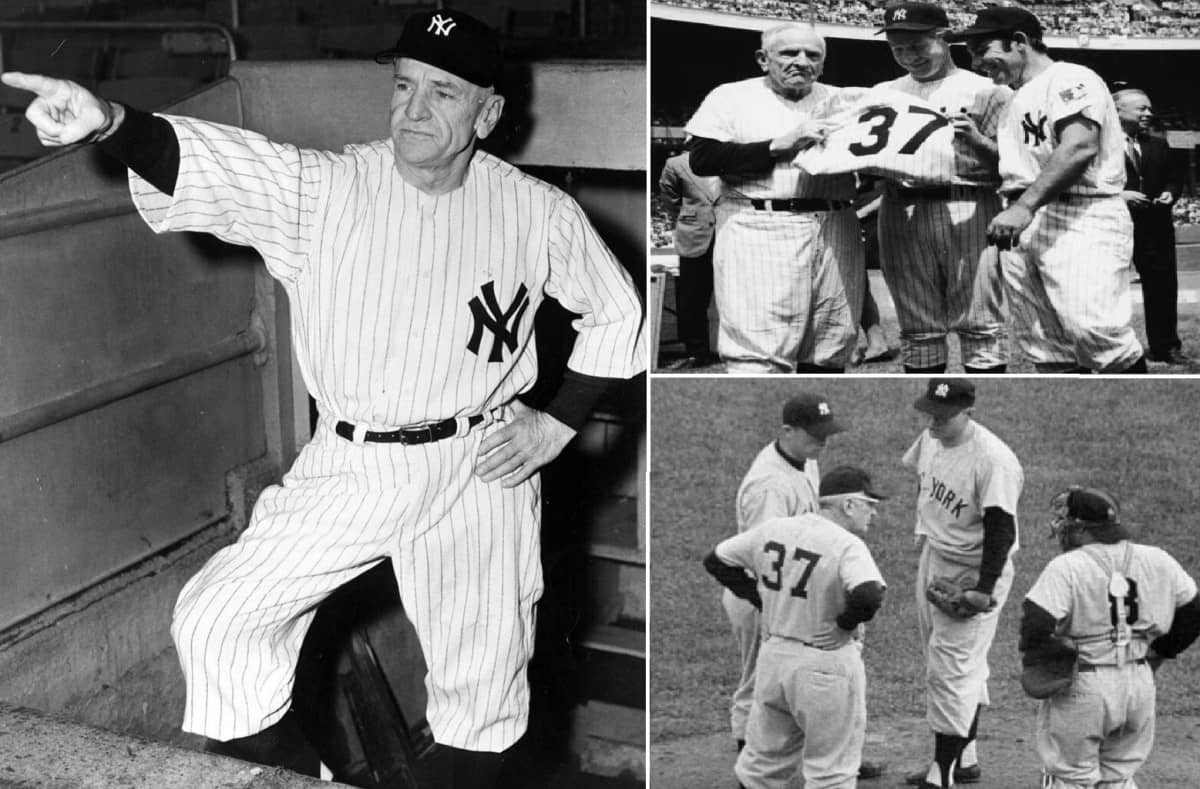

Esteban Quiñones
More Stories By Esteban Quiñones
- Mother’s Day: How Anthony Volpe’s mom molded him into a Yankee phenom
- Yankees’ Gleyber Torres projected to sign with NL West contender
- Yankees keeping tabs on Santander while Soto decision looms, says insider
- Hal Steinbrenner calls Juan Soto talks ‘good’ as Yankees weigh free agency moves
- Dave Sims excited to fill big shoes in Yankees booth, Sterling mulls weekly show
Table of Contents
| Position | Right fielder, manager |
| Active years | 1912-1925 |
| Teams (years) | Brooklyn Dodgers / Superbas / Robins (1912–1917) Pittsburgh Pirates (1918–1919) Philadelphia Phillies (1920–1921) New York Giants (1921–1923) Boston Braves (1924–1925) |
| Debut | September 17, 1912, for the Brooklyn Dodgers |
| Last game | May 19, 1925, for the Boston Braves |
| Date of Birth | July 30, 1890 |
| Native place | Glendale, California, U.S |
| Batted | Left |
| Threw | Left |
| World Champions | 9× World Series champion (1921, 1922, 1949–1953, 1956, 1958) |
| Shirt retired | Number 37 (Yankees and Mets) |
| Hall of Fame year | 1966 Veterans Committee |
| MLB Awards | Sporting News Manager of the Year Award (1958) |
| Major League Baseball All-Time Team | |
| Legacy | Monument Park honoreeNew York Mets Hall of Fame |
| Manager of teams | Brooklyn Dodgers (1934–1936) Boston Braves (1938–1943) New York Yankees (1949–1960) New York Mets (1962–1965) |
| Coach of team | Brooklyn Dodgers (1932–1933) |
| Nickname | The Ol’ Perfessor |
The Bio
Half a century ago, on August 8, 1970, a significant event unfolded at the New York Yankees’ camp as they ceremoniously retired Casey Stengel‘s iconic Number 37. Stengel, a revered figure in baseball, made a name for himself as the manager of the Yankees, dominating the MLB from 1949 to 1958 with an extraordinary seven World Series victories. His stellar achievements earned him a spot in the prestigious Cooperstown Hall of Fame in 1966.
Marty Appel, a respected baseball author and historian, dubbed Casey Stengel “Baseball’s Greatest Character.” Casey Stengel’s claim to fame stems from his unparalleled feat of securing five consecutive World Series titles from 1949 to 1953—a milestone etched in baseball history. Beyond the confines of the baseball diamond, his influence extended far and wide, evident in his appearance on the cover of Time Magazine twice, a testament to his widespread cultural impact.
During Casey Stengel’s twelve-year tenure at the helm, the New York Yankees reached unprecedented heights, clinching a remarkable 10 pennants and seven coveted World Series championships. This era marked the zenith of managerial success in baseball history. Notably, in only one season out of those twelve, Casey Stengel’s teams fell short of the 90-game mark. His illustrious record as the Yankees’ manager stands at an impressive 1,149 wins to 696 losses, resulting in an exceptional winning percentage of .623.
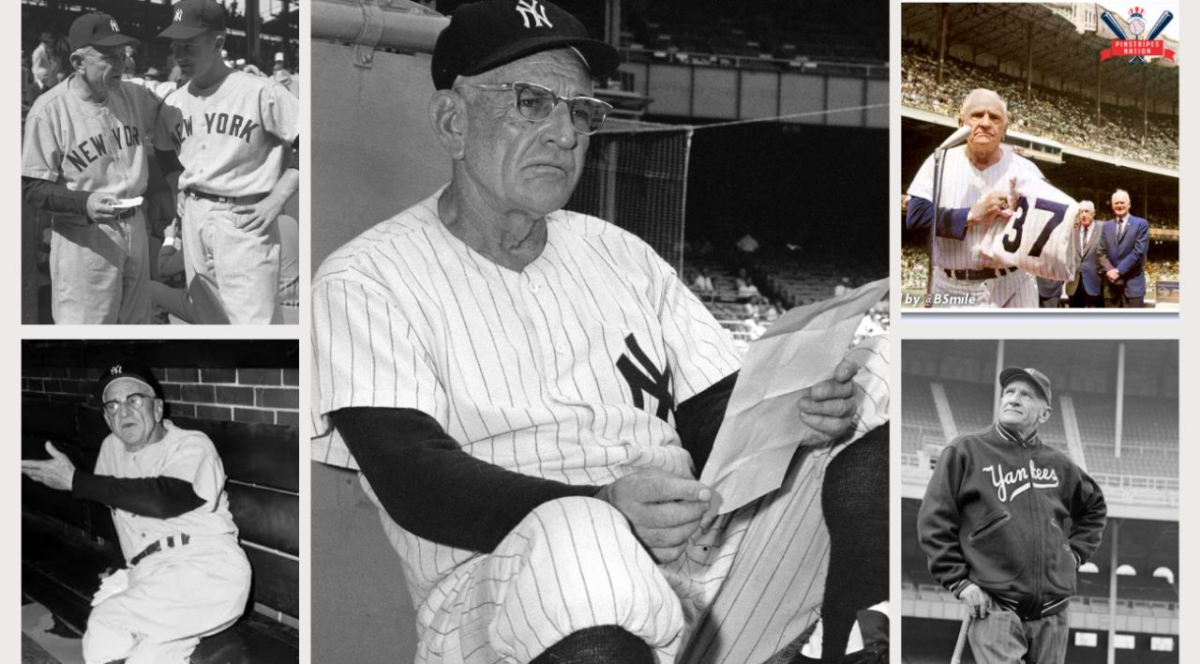
Casey Stengel’s playing career
During the pinnacle of his playing career, Casey Stengel graced the baseball stage alongside the legendary Babe Ruth. A noteworthy chapter in his playing history unfolded as he sported the New York Giants’ uniform under the astute guidance of manager John McGraw, an experience that bestowed invaluable wisdom about the game. Casey Stengel’s personal batting record showcased a commendable lifetime average of .284, yet his true brilliance surfaced in the World Series, where he flaunted an impressive .393 batting average. However, it wasn’t merely his batting statistics that carved his name into the baseball chronicles; it was his vibrant personality and captivating demeanor that rendered him truly unforgettable.
In a memorable incident at Ebbets Field, following his transfer from the Brooklyn Dodgers to the Pittsburgh Pirates, Casey Stengel faced his former team. Confronting a hostile reception from the crowd, he opted for an unconventional response. Amidst echoing boos, the outfielder gracefully took an impromptu bow, and to everyone’s amazement, he unveiled a concealed sparrow as he doffed his cap. The bird took flight within the stadium, instantly transforming the atmosphere from animosity to pure amusement. Laughter erupted, and the crowd burst into applause, all thanks to this unexpected and entertaining spectacle.
The 1921 World Series unveils another intriguing tale, as Casey Stengel, though not actively participating in the game, ingeniously left his mark in the official records by getting ejected after a fervent dispute with the umpire.
In a surprising twist contrary to common belief, it was Casey Stengel, not Babe Ruth, who initiated the home run tally at the newly established Yankee Stadium during Game 1 of the 1923 World Series, significantly contributing to the New York Giants’ triumph. the right fielder repeated this feat in Game 3 with yet another decisive home run. While circling the bases, he whimsically blew kisses to the crowd, all the while teasing Babe Ruth and the Yankees’ dugout.
Casey Stengel’s managerial career
In 1925, Casey Stengel started the season on the active roster of the Boston Braves, primarily used as a pinch hitter and making only one start in right field against the Pirates on May 14. That game saw him achieve his only MLB hit of the season, a single, marking the final hit of his major league career as his batting average dropped to .077. Soon after, Braves owner Emil Fuchs acquired the Worcester Panthers of the Eastern League and appointed Stengel as player-manager and team president.

Released in 1926, Casey Stengel joined the Giants’ top affiliate, the Toledo Mud Hens of the American Association. His leadership brought the Mud Hens close to a pennant in his first year, though they ultimately placed third. In 1927, the team claimed its first pennant, though Casey Stengel was suspended after inciting fans against an umpire. Continuing as an occasional player, he hit a game-winning home run that year, the last of his career. However, following a last-place finish in 1931, he was fired.
In 1932, Casey Stengel was hired as the Dodgers’ first base coach, becoming manager in 1934. Despite limited success, he managed until 1936. Later, in 1938, he managed the Boston Braves but never achieved a top-half finish. After a car accident in 1943, he returned to managing with the Milwaukee Brewers in 1944, later joining the Yankees’ Kansas City Blues affiliate. In 1946, Casey Stengel took over as manager for the Oakland Oaks in the Pacific Coast League.
In 1946, Casey Stengel guided the Oakland Oaks to an admirable second-place finish in the Pacific Coast League. Then, in 1948, during his second tenure as the manager of the Oakland Oaks, he guided the team to an emphatic victory, securing the minor league championship, with a young Billy Martin among his players. This triumph laid the groundwork for the most significant accomplishment in Casey Stengel’s career.
In 1946, Yankees manager Joe McCarthy retired mid-season, leading to the temporary appointment of catcher Bill Dickey as player-manager. The following year, Bucky Harris was chosen for the managerial role, though there had been early speculation around Casey Stengel potentially filling the position before Harris was appointed. Later, Harris was dismissed from the job, reportedly due to his refusal to share his home phone number with George Weiss. Yankees scouts on the West Coast subsequently recommended Casey Stengel, and he was ultimately offered the position.
Del Webb, one of the New York Yankee owners, summoned him to take charge of the Yankees, a proposition endorsed by the serious and business-minded General Manager George Weiss, a longtime friend of Casey Stengel.
On the 12th of October in 1948, a mere six days following the departure of the Yankees’ former manager, Bucky Harris, Casey Stengel assumed control of the team. This individual, once nurturing aspirations of becoming a left-handed dentist, now found himself leading the New York Yankees. The formal introduction unfolded at a lavish press conference and luncheon hosted at the upscale 21 Club in Manhattan.
Addressing the gathered audience, Casey Stengel humorously acknowledged that some might perceive him as a jester due to his inclination for eliciting laughter. However, he stressed that his appointment was not solely a product of personal camaraderie. Casey Stengel emphasized that the Yankees represented a significant financial investment, and such crucial positions were not granted purely based on personal affability. His assertion was unambiguous: he had been selected for the role because those involved believed he possessed the fortitude to deliver the desired outcomes.
Casey Stengel as Yankees manager

Casey Stengel faced a formidable challenge in his first year as the rookie manager of the Yankees. The team grappled with a series of injuries that sidelined key players, including the renowned outfield trio of Charlie Keller, Joe DiMaggio, and Tommy Henrich. Keller was out for the entire season, DiMaggio’s heel injury kept him sidelined until June 28, and standout shortstop Phil Rizzuto also missed a substantial part of the season.
Despite these setbacks, Casey Stengel showcased his prowess as a master strategist, skillfully navigating the hurdles. He relied on players like Cliff Mapes, Dick Kryhoski, and Fenton Mole, who weren’t the team’s headline names. Through adept roster management, Casey Stengel successfully juggled and combined different players, adjusting his lineup from game to game while effectively guiding the team through adversities.
Under his astute leadership, the Yankees embarked on the journey to secure an unprecedented five consecutive World Championships starting in 1949. In that inaugural year, his influence permeated all aspects of the Yankees’ operations. While a Yankee culture already existed, his impact transformed it into a distinctive Casey Stengel Yankee culture, shaping the team throughout the 1949 season and his tenure as manager. This culture became a lasting part of the Yankees’ tradition for years to come.
Fondly referred to as the “Ol’ Professor” for his distinctive voice, Casey Stengel rose to iconic status within the Yankees organization, achieving a level of renown that, in some circles, rivaled or even surpassed that of his star players. His popularity extended beyond the confines of baseball, earning him nationwide recognition.
Upon assuming control of the Yankees, the team was already perceived as a formidable force. However, in a mere three years, Casey Stengel orchestrated a remarkable transformation. Instead of heavily relying on high-profile stars, he shifted his focus to nurturing a core trio of players: Mickey Mantle, Yogi Berra, and Whitey Ford. The rest of the roster predominantly comprised role players, as the manager fostered a culture of healthy competition for playing time, motivating his players to strive for excellence. Devotion to the team and a sense of pride in being part of the Yankees became fundamental principles. Players recognized that under Casey Stengel’s guidance, postseason aspirations were a tangible reward for their commitment to the team.
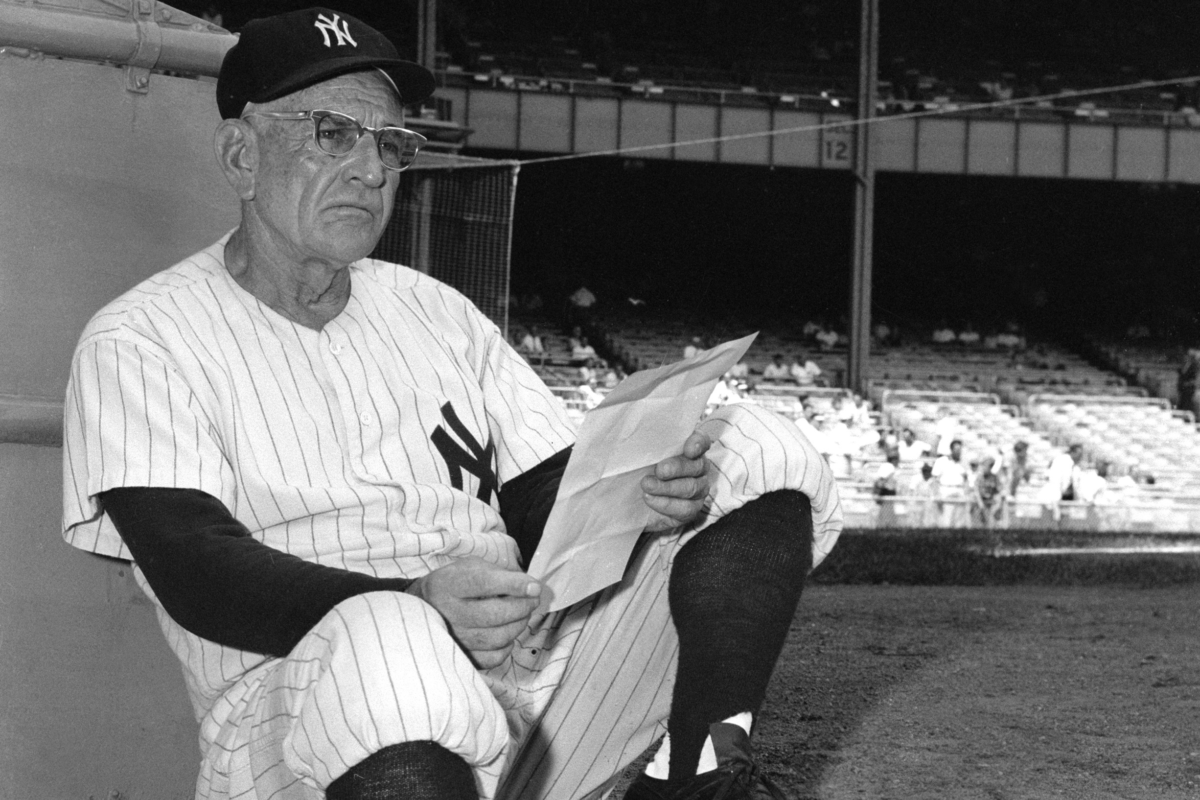
In 1958, the Yankees clinched the pennant with a comfortable 10-game lead and went to snatch the World Series from the jaws of defeat. However, the year 1959 saw a decline, as the team finished in third place, marking the nadir of Casey Stengel’s tenure. This dip in performance led to speculation that the team’s golden era might be fading. Approaching the age of 70, the manager became more impatient, making unconventional moves during games that even surprised him.
Nevertheless, in 1960, amidst a challenging pennant race, Casey Stengel rallied the Yankees to secure another pennant. Unfortunately, Bill Mazeroski’s walk-off home run in the World Series handed the championship to Pittsburgh.
Yankee owners Dan Topping and Del Webb, who had contemplated parting ways with Casey Stengel for some time, seized on the World Series loss to the Pirates as a pretext for his dismissal. He was let go, a decision prompted by a rule mandating retirement at the age of 65, specifically applied to him.
Casey Stengel’s life after Yankees’ manager
After achieving seven World Series Championships with the New York Yankees, Casey Stengel received an unexpected offer to manage the struggling 1962 New York Mets, an expansion team. He, known for his unique way of speaking, dubbed “Stengelese,” entertained the press and skillfully diverted attention from the team’s lackluster on-field performance. He adeptly utilized this distinctive speech style to evade direct questions. When asked about the construction of the new Shea Stadium for the Mets, Casey Stengel humorously remarked, “The park is lovelier than my team.” In a surprising turn of events, the Mets secured the 1969 World Series after his retirement. Despite not actively managing, he was credited with creating a diversion that contributed to the team’s success, earning him another championship ring.
Casey Stengel holds the 13th spot on the MLB’s all-time wins list, boasting an impressive total of 1,905 victories, with a career winning percentage of .508%. These outstanding statistics, coupled with his seven World Series championships, undeniably establish him as one of the most distinguished managers in the history of the game. However, some critics argue that he had the privilege of leading one of the most talented lineups in MLB history.
Given his age, Major League Baseball granted a special exemption to the usual 5-year waiting period, leading to Casey Stengel, along with Ted Williams, being inducted into the Baseball Hall of Fame in 1966. His speech at the induction ceremony in Cooperstown made a lasting impression, and over his years in the game, he left behind a wealth of memorable quotes.
Casey Stengel’s final battle with cancer concluded with his passing in 1975, and Forest Lawn became his final resting place. During the poignant eulogy, delivered by Rod Dedeaux, a baseball coach at the University of Southern California and a long-time friend of the Stengels, Jim Murray’s column was quoted. It astutely observed, “Well, God is certainly getting an earful tonight,” paying tribute to Casey Stengel’s enduring presence.
Greatest moments and awards of Casey Stengel
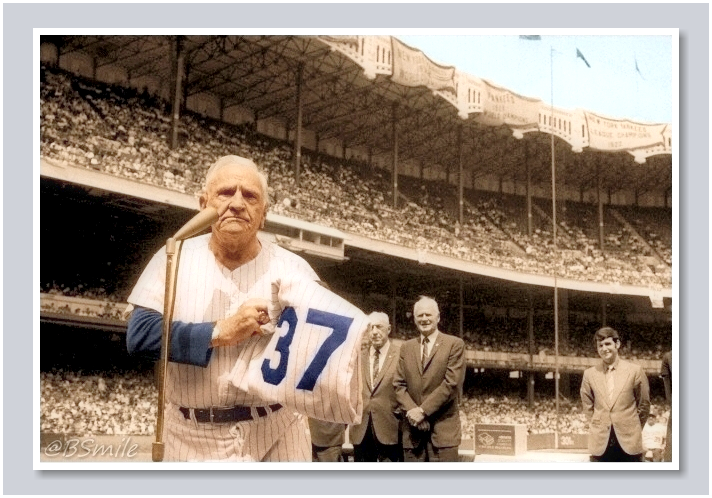
Casey Stengel had a long and storied career in baseball, first as a player and then as a manager. He is best known for his managerial accomplishments with the New York Yankees of the 1950s and the New York Mets of the early 1960s. Here are some of his greatest career moments and achievements:
- Seven World Series titles: He led the Yankees to seven World Series titles during his tenure as manager.
- Most World Series victories: Casey Stengel holds the record for most World Series victories at 37, and most fall classic games managed at 63.
- Platooning: His adjustments in the lineup during certain junctures of the game made the concept of platooning famous throughout the league.
- Stengelese: He was known for his odd sayings, called “Stengelese,” which became part of his legend.
- Baseball Hall of Fame: Stengel was inducted into the Baseball Hall of Fame in 1966.
- Solid right field: Casey Stengel was a solid right fielder for the Brooklyn Dodgers and accumulated a respectable 159 win-shares in his career.
- Lovable Losers: He managed the New York Mets, an expansion team that became known as the “Lovable Losers”.
- Testimony before Congress: In 1958, Casey Stengel testified before a United States Senate committee which was investigating baseball’s anti-trust exemption. His forty-five minutes at the microphone were a comic tour de force and added to his reputation for double-talking.
- Despite being described as a clown and a failure as a manager before joining the Yankees, his success during the Yankee years is undeniable. He is remembered as one of the great characters in baseball history.
FAQ
Which MLB team was the first to hire Casey Stengel?
Brooklyn Dodgers
How did Casey Stengel lose the 1960 World Series?
Casey Stengel did not lose the 1960 World Series as he was not the manager of any team that participated in that World Series.
When did Casey Stengel manage the Mets?
Casey Stengel managed the Mets from 1962 to 1965.
How many championships did Casey Stengel manage?
Casey Stengel managed seven World Series championships with the New York Yankees.
Who is Casey Stengel?
Casey Stengel was an American Major League Baseball right fielder and manager, best known as the manager of the championship New York Yankees
When did Casey Stengel join the Yankees?
Casey Stengel joined the Yankees on October 12, 1948, as their manager.
Who is considered the best manager John McGraw or Casey Stengel?
There is no clear answer to this question as it is subjective and depends on personal opinions.
How old was Casey Stengel when he managed the Mets?
Casey Stengel was 71 years old when he managed the Mets.
How many years did Yogi Berra play for Casey Stengel?
Yogi Berra played for Casey Stengel for 12 years.
What years did Casey Stengel manage the Yankees?
Casey Stengel managed the Yankees from 1949 to 1960.
How old was Casey Stengel when he died?
Casey Stengel was born on July 30, 1890, and died on September 29, 1975, making him 85 years old when he died.
What years did Casey Stengel manage the Yankees?
Casey Stengel managed the Yankees from 1949 to 1960.
How old was Casey Stengel when he retired?
Casey Stengel retired from managing at the age of 74.
When did Casey Stengel manage the Yankees?
Casey Stengel managed the Yankees from 1949 to 1960.
What made Casey Stengel charismatic?
Casey Stengel was known for his odd sayings, called “Stengelese,” and his showmanship.
Who replaced Casey Stengel as manager of the Mets?
Wes Westrum replaced Casey Stengel as manager of the Mets.
When was Casey Stengel manager of the NY Yankees?
Casey Stengel was the manager of the NY Yankees from 1949 to 1960.
When did Casey Stengel die?
Casey Stengel died on September 29, 1975.
What college plays at Casey Stengel Stadium?
Glendale College plays at Casey Stengel Stadium.
Did Casey Stengel say “hit em where they ain’t”?
Yes, Casey Stengel said “hit em where they ain’t.”
Where was Casey Stengel born?
Casey Stengel was born in Kansas City, Missouri, United States.
What years did Casey Stengel coach the New York Yankees?
Casey Stengel managed the New York Yankees from 1949 to 1960.
Who replaced Casey Stengel?
Ralph Houk replaced Casey Stengel as manager of the Yankees.
What made Casey Stengel charismatic for the Mets?
Casey Stengel was known for his odd sayings, called “Stengelese,” and his showmanship.
How many World Series did Casey Stengel win?
Casey Stengel won 7 World Series championships with the New York Yankees.
How long did Casey Stengel manage the Mets?
Casey Stengel managed the Mets from 1962 to 1965.
Casey Stengel: Stats
| SUMMARY | WAR | AB | H | HR | BA | R | RBI | SB | OBP | SLG | OPS | OPS+ |
| Career | 20.2 | 4288 | 1219 | 60 | 0.284 | 575 | 535 | 131 | 0.356 | 0.41 | 0.766 | 120 |
Standard batting
| Year | G | PA | AB | R | H | 2B | 3B | HR | RBI | SB | CS | BB | SO | BA | OBP | SLG | OPS | OPS+ | TB | GDP | HBP | SH | SF | IBB | Pos |
| 1912 | 17 | 74 | 57 | 9 | 18 | 1 | 0 | 1 | 13 | 5 | 15 | 9 | 0.316 | 0.466 | 0.386 | 0.852 | 138 | 22 | 1 | 1 | 8 | ||||
| 1913 | 124 | 503 | 438 | 60 | 119 | 16 | 8 | 7 | 43 | 19 | 17 | 56 | 58 | 0.272 | 0.356 | 0.393 | 0.748 | 112 | 172 | 1 | 7 | *8/H9 | |||
| 1914 | 126 | 484 | 412 | 55 | 130 | 13 | 10 | 4 | 60 | 19 | 56 | 55 | 0.316 | 0.404 | 0.425 | 0.829 | 144 | 175 | 5 | 10 | *9/H8 | ||||
| 1915 | 132 | 510 | 459 | 52 | 109 | 20 | 12 | 3 | 50 | 5 | 10 | 34 | 46 | 0.237 | 0.294 | 0.353 | 0.647 | 93 | 162 | 3 | 14 | *9/H | |||
| 1916 | 127 | 511 | 462 | 66 | 129 | 27 | 8 | 8 | 53 | 11 | 33 | 51 | 0.279 | 0.329 | 0.424 | 0.753 | 127 | 196 | 1 | 15 | *9/H | ||||
| 1917 | 150 | 622 | 549 | 69 | 141 | 23 | 12 | 6 | 73 | 18 | 60 | 62 | 0.257 | 0.336 | 0.375 | 0.711 | 116 | 206 | 5 | 8 | *9/8 | ||||
| 1918 | 39 | 142 | 122 | 18 | 30 | 4 | 1 | 1 | 12 | 11 | 16 | 14 | 0.246 | 0.343 | 0.32 | 0.663 | 99 | 39 | 2 | 2 | 9/H | ||||
| 1919 | 89 | 370 | 321 | 38 | 94 | 10 | 10 | 4 | 43 | 12 | 35 | 35 | 0.293 | 0.364 | 0.424 | 0.788 | 133 | 136 | 1 | 13 | 9/H | ||||
| 1920 | 129 | 504 | 445 | 53 | 130 | 25 | 6 | 9 | 50 | 7 | 13 | 38 | 35 | 0.292 | 0.356 | 0.436 | 0.792 | 124 | 194 | 6 | 15 | *9H/87 | |||
| 1921 | 42 | 89 | 81 | 11 | 23 | 4 | 1 | 0 | 6 | 1 | 2 | 7 | 12 | 0.284 | 0.341 | 0.358 | 0.699 | 81 | 29 | 0 | 1 | H9/8 | |||
| 1921 | 24 | 66 | 59 | 7 | 18 | 3 | 1 | 0 | 4 | 1 | 1 | 6 | 7 | 0.305 | 0.369 | 0.39 | 0.759 | 96 | 23 | 0 | 1 | 9/H | |||
| 1921 | 18 | 23 | 22 | 4 | 5 | 1 | 0 | 0 | 2 | 0 | 1 | 1 | 5 | 0.227 | 0.261 | 0.273 | 0.534 | 41 | 6 | 0 | 0 | H/98 | |||
| 1922 | 84 | 283 | 250 | 48 | 92 | 8 | 10 | 7 | 48 | 4 | 2 | 21 | 17 | 0.368 | 0.436 | 0.564 | 1 | 154 | 141 | 9 | 3 | 8H/97 | |||
| 1923 | 75 | 246 | 218 | 39 | 74 | 11 | 5 | 5 | 43 | 6 | 2 | 20 | 18 | 0.339 | 0.4 | 0.505 | 0.905 | 137 | 110 | 2 | 6 | 8H/7 | |||
| 1924 | 131 | 518 | 461 | 57 | 129 | 20 | 6 | 5 | 39 | 13 | 13 | 45 | 39 | 0.28 | 0.348 | 0.382 | 0.73 | 100 | 176 | 3 | 9 | 3 | *9/H8 | ||
| 1925 | 12 | 15 | 13 | 0 | 1 | 0 | 0 | 0 | 2 | 0 | 1 | 1 | 2 | 0.077 | 0.143 | 0.077 | 0.22 | -40 | 1 | 0 | 1 | 0 | H/9 | ||
| G | PA | AB | R | H | 2B | 3B | HR | RBI | SB | CS | BB | SO | BA | OBP | SLG | OPS | OPS+ | TB | GDP | HBP | SH | SF | IBB | ||
| 14 Yrs | 1277 | 4871 | 4288 | 575 | 1219 | 182 | 89 | 60 | 535 | 131 | 60 | 437 | 453 | 0.284 | 0.356 | 0.41 | 0.766 | 120 | 1759 | 39 | 105 | 3 | |||
| 162 Game Avg. | 162 | 618 | 544 | 73 | 155 | 23 | 11 | 8 | 68 | 17 | 55 | 57 | 0.284 | 0.356 | 0.41 | 0.766 | 120 | 223 | 5 | 13 |
Postseason batting
| Year | G | PA | AB | R | H | 2B | 3B | HR | RBI | SB | CS | BB | SO | BA | OBP | SLG | OPS | TB | GDP | HBP | SH | SF | IBB | WPA | cWPA |
| 1916 | 4 | 12 | 11 | 2 | 4 | 0 | 0 | 0 | 0 | 0 | 0 | 1 | 0.364 | 0.364 | 0.364 | 0.727 | 4 | 0 | 1 | 0 | 0.06 | 1.70% | |||
| 1921 | Did not play | ||||||||||||||||||||||||
| 1922 | 2 | 5 | 5 | 0 | 2 | 0 | 0 | 0 | 0 | 0 | 0 | 0 | 1 | 0.4 | 0.4 | 0.4 | 0.8 | 2 | 0 | 0 | 0 | 0.03 | 1.30% | ||
| 1923 | 6 | 16 | 12 | 3 | 5 | 0 | 0 | 2 | 4 | 0 | 0 | 4 | 0 | 0.417 | 0.563 | 0.917 | 1.479 | 11 | 0 | 0 | 0 | 0.66 | 22.30% | ||
| 3 Yrs (3 Series) | 12 | 33 | 28 | 5 | 11 | 0 | 0 | 2 | 4 | 0 | 0 | 4 | 2 | 0.393 | 0.469 | 0.607 | 1.076 | 17 | 0 | 1 | 0 | 0.75 | 25.20% | ||
| 4 WS | 12 | 33 | 28 | 5 | 11 | 0 | 0 | 2 | 4 | 0 | 0 | 4 | 2 | 0.393 | 0.469 | 0.607 | 1.076 | 17 | 0 | 1 | 0 | 0.75 | 25.20% | ||
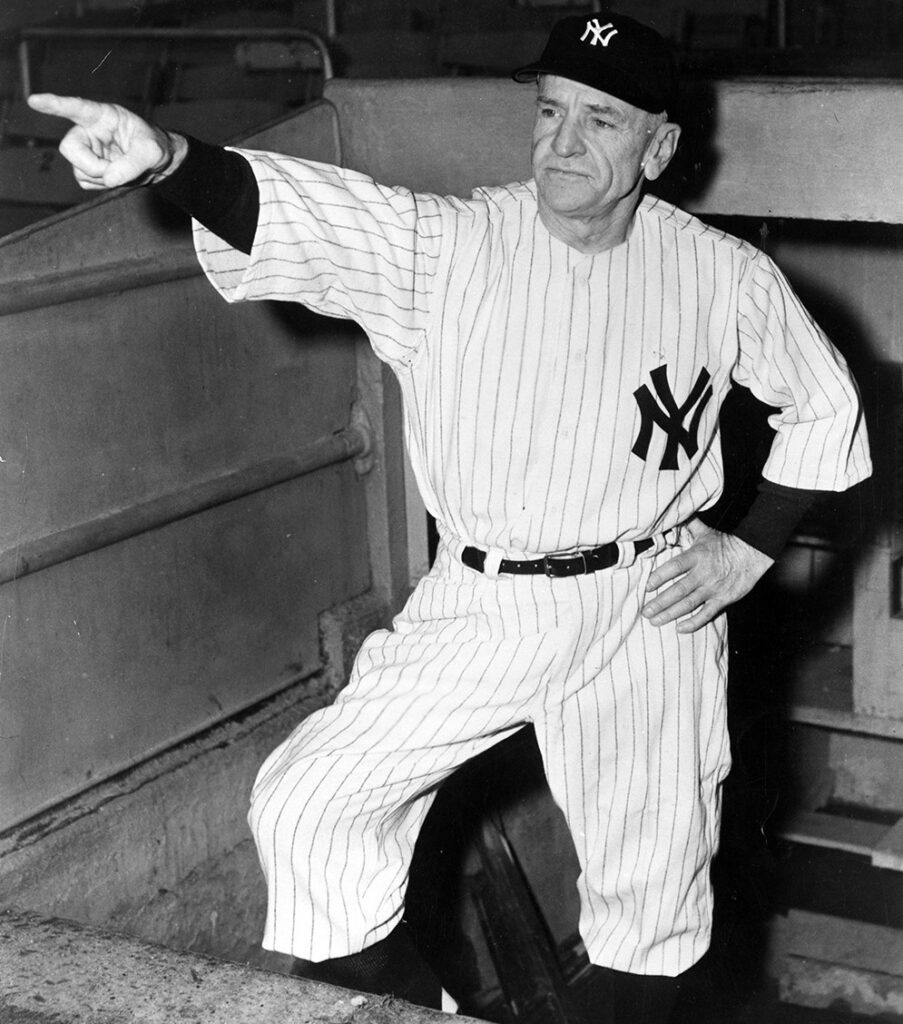
Career graph
| Hall of Fame | Batting Average | On-Base% | Slugging % |
| 1938 BBWAA ( 0.8%) 1939 BBWAA ( 2.2%) 1945 BBWAA ( 0.8%) 1948 BBWAA ( 0.8%) 1949 BBWAA ( 2.0%) 1950 BBWAA ( 1.8%) 1951 BBWAA ( 3.5%) 1952 BBWAA (11.5%) 1953 BBWAA (23.1%) 1966 Veterans (inducted) Selected to HOF in 1966 by Veteran’s Committee | 1914 NL .316 (5th) | 1914 NL .404 (1st) 1919 NL .364 (8th) | 1914 NL .425 (7th) 1916 NL .424 (8th) 1919 NL .424 (6th) 1920 NL .436 (10th) |
| On-Base Plus Slugging | Games Played | Plate Appearances | Doubles |
| 1914 NL .829 (5th) 1916 NL .753 (9th) 1919 NL .788 (6th) 1920 NL .792 (10th) | 1917 NL 150 (10th) | 1917 NL 622 (8th) | 1916 NL 27 (9th) |
| Triples | Home Runs | Runs Batted In | Bases on Balls |
| 1914 NL 10 (8th) 1915 NL 12 (6th) 1917 NL 12 (10th) Career 89 (219th) | 1913 NL 7 (10th) 1916 NL 8 (6th) 1917 NL 6 (4th) 1920 NL 9 (6th) | 1917 NL 73 (4th) | 1917 NL 60 (6th) |
| Strikeouts | Adjusted OPS+ | Adj. Batting Runs | Adj. Batting Wins |
| 1917 NL 62 (7th) | 1914 NL 144 (5th) 1919 NL 133 (7th) | 1914 NL 25 (6th) | 1914 NL 2.7 (6th) |
| Extra Base Hits | Times On Base | Offensive Win % | Hit By Pitch |
| 1916 NL 43 (7th) 1917 NL 41 (8th) | 1917 NL 206 (10th) | 1914 NL .751 (4th) 1916 NL .679 (8th) 1919 NL .691 (7th) | 1920 NL 6 (10th) 1922 NL 9 (1st) |
| Power-Speed # | AB per HR | Base-Out Runs Added (RE24) | Win Probability Added (WPA) |
| 1913 NL 10.2 (10th) 1917 NL 9.0 (3rd) 1920 NL 7.9 (9th) | 1913 NL 62.6 (9th) 1916 NL 57.8 (4th) 1917 NL 91.5 (8th) 1919 NL 80.3 (6th) 1920 NL 49.4 (3rd) | 1914 NL 34.38 (6th) 1919 NL 15.21 (8th) 1922 NL 29.05 (9th) | 1922 NL 2.6 (10th) |
| Situ. Wins Added (WPA/LI) | Championship WPA (cWPA) | Base-Out Wins Added (REW) | Def. Games as CF (s.1901) |
| 1914 NL 2.9 (6th) 1919 NL 1.4 (7th) 1922 NL 2.4 (9th) | 1916 NL 11.7 (2nd) 1922 NL 6.4 (6th) 1923 NL 8.6 (5th) Career 26.7 (164th) | 1914 NL 3.8 (6th) 1919 NL 1.7 (8th) 1922 NL 2.7 (9th) | 1913 NL 117 (5th) |
| Putouts as CF (s.1901) | Assists as CF (s.1901) | Errors Committed as CF (s.1901) | Double Plays Turned as CF (s.1901) |
| 1913 NL 270 (5th) | 1913 NL 16 (3rd) | 1913 NL 12 (1st) | 1922 NL 2 (4th) |
| Def. Games as RF (s.1901) | Putouts as RF (s.1901) | Assists as RF (s.1901) | Errors Committed as RF (s.1901) |
| 1914 NL 120 (4th) 1915 NL 129 (4th) 1916 NL 121 (5th) 1917 NL 149 (1st) 1920 NL 112 (5th) 1924 NL 121 (3rd) | 1914 NL 172 (5th) 1915 NL 220 (4th) 1916 NL 204 (3rd) 1917 NL 251 (2nd) 1919 NL 195 (5th) 1920 NL 194 (5th) 1924 NL 206 (4th) | 1914 NL 15 (4th) 1915 NL 13 (5th) 1916 NL 15 (5th) 1917 NL 30 (1st) 1920 NL 16 (3rd) 1924 NL 11 (4th) Career 119 (37th) | 1914 NL 7 (4th) 1915 NL 10 (5th) 1916 NL 8 (3rd) 1917 NL 9 (5th) 1919 NL 9 (5th) 1920 NL 11 (2nd) Career 63 (40th) |
| Double Plays Turned as RF (s.1901) | Def. Games as OF | Assists as OF | Errors Committed as OF |
| 1914 NL 5 (5th) 1915 NL 2 (5th) 1916 NL 5 (1st) 1917 NL 8 (1st) 1918 NL 3 (4th) 1919 NL 3 (4th) 1924 NL 4 (2nd) Career 33 (22nd) | 1917 NL 150 (5th) | 1917 NL 30 (1st) | 1913 NL 12 (5th) |
| Double Plays Turned as OF | Range Factor/Game as CF (s.1901) | Fielding % as CF (s.1901) | Range Factor/Game as RF (s.1901) |
| 1917 NL 9 (1st) 1924 NL 4 (4th) | 1913 NL 2.44 (3rd) | 1913 NL .960 (5th) | 1914 NL 1.56 (4th) 1915 NL 1.81 (1st) 1916 NL 1.81 (3rd) 1917 NL 1.89 (3rd) 1919 NL 2.32 (1st) 1920 NL 1.88 (5th) |
| Fielding % as RF (s.1901) | Fielding % as OF | ||
| 1914 NL .964 (2nd) 1915 NL .959 (2nd) 1916 NL .965 (5th) 1917 NL .969 (1st) 1920 NL .950 (4th) 1924 NL .977 (2nd) | 1924 NL .978 (3rd) |
- Categories: Casey Stengel
- Tags: Casey Stengel


 Follow Us
Follow Us